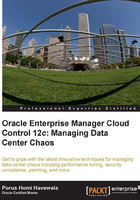
Chapter 2. Enter Oracle Cloud Control
What if we told you that there is an enterprise-class management product from Oracle, which, if used appropriately, would help in resolving the chaos of the data centers?
Yes, there indeed is such a product. Enter Oracle Enterprise Manager Cloud Control 12c, which is the latest version of Oracle's Enterprise Manager. This is installed centrally on a dedicated server and used for managing and monitoring the entire Oracle Technology Stack, with an Agent placed on each Target that Enterprise Manager is to manage or monitor.
In the previous versions of Enterprise Manager, 11g and 10g, the product could optionally be installed locally when the database software or application server software was installed on a server. In this cut-down form, it was known as Oracle Database Control or Oracle Application Server Control, respectively. This type of single Target Enterprise Manager is no longer available in the 12c version at the time of writing this book.
What we do have is Cloud Control 12c, which is the full, all-encompassing flavor of Oracle Enterprise Manager. Appropriately named, Cloud Control 12c can manage the 9i, 10g, and 11g versions of Oracle databases, and Oracle middleware, including Oracle Fusion, Oracle WebLogic Server, Oracle SOA Suite, and Oracle Application Server. Cloud Control 12c can also manage Oracle Applications such as Fusion Apps, Siebel, E-Business Suite, PeopleSoft, and JD Edwards Enterprise One. It also manages Oracle VM and Oracle Sun Servers and Storage in the form of Enterprise Manager Ops Center 12c.
Thus, it is apparent that Cloud Control 12c can do application-to-disk management, as it manages everything from the application down to the database, middleware, virtual machine, server, and storage (disk) level.
Cloud Control 12c even goes above, to the business layer, and is able to define and manage your business transactions on services across a service bus, and can be used to set up the entire infrastructure for the Cloud—whether the Cloud is Infrastructure as a Service (IaaS), Database as a Service (DBaaS), or Platform as a Service (PaaS).
It is also able to deliver the Cloud via self service, and manage the Cloud, including metering and chargeback services. As business transaction management capabilities are included, this means Enterprise Manager Cloud Control 12c is able to achieve business-driven Cloud Management.
The DbaaS Cloud capabilities of Enterprise Manager are based on the database lifecycle management features of the product. We will go through the database lifecycle management features in the coming chapters.
And besides the Oracle technology stack, Enterprise Manager Cloud Control 12c is able to monitor and perform configuration management of non-Oracle hardware and software, such as non-Oracle Hosts (for example, HP-UX, IBM AIX, and Windows), non-Oracle storage such as EMC and NetApp, as well as firewalls, load balancers, and network devices.
This is done via Enterprise Manager plugins written either by Oracle or third-party vendors. At the time of writing this book, a few of the plugins are being rewritten for Cloud Control and will be released in stages.
But is Cloud Control 12c a new product, or does it have a long history? The answer is yes to both. To understand this, we will have to go back in time.
Oracle Enterprise Manager Cloud Control 12c is certainly a long way from the days of Oracle Server Manager, the initial version that was released in the mid 1990s and was a simple and limited GUI interface used for some aspects of database administration only (along with a command-line interface, server manager line mode, or svrmgrl).
The DBAs at that time saw it as a novelty and used it very sparingly. They laughed at it. But it was the first attempt by Oracle at a GUI management tool.
This was followed by Oracle Enterprise Manager, called OEM initially. First OEM Version 1 was released, followed by OEM Version 2.2, which could be used with Oracle Database 8i. The next version, OEM 9i could be used with Oracle Database 9i and this was a much better-looking Java console that had to be installed on your Windows PC or workstation. Even though there were Java-related memory and performance issues with this version, it had increased acceptance among DBAs, who started using it in greater numbers.
The next version, Enterprise Manager (EM) 10g was introduced in the first decade of this century. It used the N-tier architecture, using Oracle Application Server as the backend application server for the actual Enterprise Manager Java application. This was an OC4J application, that is, Oracle Containers For J2EE (OC4J) 10g, which was compliant with Java 2 Enterprise Edition (J2EE) 1.4. The Enterprise Manager application was installed centrally as one or more Management Services using the same Central Repository, with Management Agents installed on multiple Targets that communicated with the Management Service. This type of centralized installation of Enterprise Manager was called Grid Control .
The backend application server OC4J application was replaced by Oracle WebLogic Server in Enterprise Manager 11g, released in April 2010. This version, for the first time, required the WebLogic Server software to be installed first, before the Enterprise Manager 11g Grid Control software was installed.
Enterprise Manager Grid Control 10g could manage 8i, 9i, 10g, as well as 11.1 databases, and other products such as Oracle Application Server. Enterprise Manager Grid Control 11g was able to manage 11.2 databases as well, although support for 8i databases was dropped.
And in October 2011, during Oracle OpenWorld, the latest Enterprise Manager 12c, renamed Cloud Control instead of Grid Control, was announced with great fanfare.